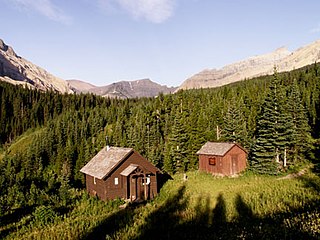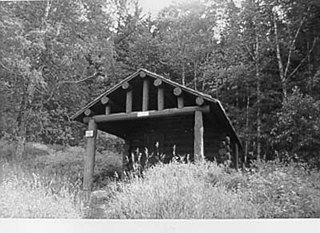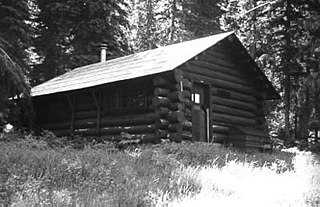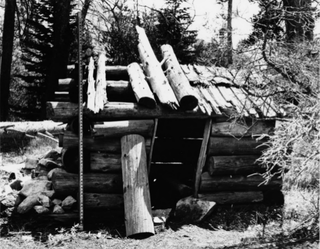
Sequoyah's Cabin is a historic log cabin and historic site off Oklahoma State Highway 101 near Akins, Oklahoma. It was the home between 1829 and 1844 of the Cherokee Indian Sequoyah, who in 1821 created a written language for the Cherokee Nation. The cabin and surrounding park, now owned by the Cherokee Nation, was declared a National Historic Landmark in 1965.

The Moran Bay Patrol Cabin was built by the Civilian Conservation Corps about 1932. The log structure was located in the northern backcountry of Grand Teton National Park, and was built to a standard design for such structures, in the National Park Service Rustic style, but for the U.S. Forest Service, which administered much of the area prior to the expansion of the park in 1943. The Upper Granite Canyon Patrol Cabin is similar.

The Upper Granite Canyon Patrol Cabin was built by the Civilian Conservation Corps about 1935. The log structure is located in the extreme southwest backcountry of Grand Teton National Park. The cabin was built according to a standard design for such structures, in the National Park Service Rustic style. The Moran Bay Patrol Cabin is similar.

The Jenny Lake Ranger Station Historic District comprises an area that was the main point of visitor contact in Grand Teton National Park from the 1930s to 1960. Located near Jenny Lake, the buildings are a mixture of purpose-built structures and existing buildings that were adapted for use by the National Park Service. The ranger station was built as a cabin by Lee Mangus north of Moose, Wyoming about 1925 and was moved and rebuilt around 1930 for Park Service use. A store was built by a concessioner, and comfort stations were built to Park Service standard plans. All buildings were planned to the prevailing National Park Service Rustic style, although the ranger station and the photo shop were built from parts of buildings located elsewhere in the park.

The Roes Creek Campground Camptender's Cabin, also known as the Rising Sun Campground Ranger Cabin, in Glacier National Park is an example of the National Park Service Rustic style.

The Sun Camp Fireguard Cabin, also known as the Baring Creek Cabin or Baring Cabin, in Glacier National Park was an example of the National Park Service Rustic style. Built in 1935 by local contractor Harry E. Doverspike, the cabin was the last remaining building of the Sun Camp Ranger Station complex of buildings, which at one time included a ranger station, barn and woodshed located near the mouth of Baring Creek. The fireguard cabin was built according to cabin specifications provided by the NPS Division of Landscape Architecture. The only apparent dissimilarity is the center-wall placement of the entry. There was no indoor plumbing and heat was provided by a wood stove whose stovepipe exited through the back log wall to a stone chimney.

The Swiftcurrent Ranger Station is an example of the Swiss Chalet style that prevailed in the early years of Glacier National Park, before the establishment of the similar National Park Service Rustic style. The station was designed by Edward A. Nickel and built by Ole Norden and S. M. Askevold. It replaced a previous ranger station, destroyed in a 1936 forest fire. All structures in the district were built within a single year and are consistent in design and materials.

The Kootenai Creek Snowshoe Cabin was built in Glacier National Park in 1926. The rustic log structure comprises a single room with a woodstove, and a small cellar food cache. The cabin was situated on the patrol route from the Goat Haunt ranger station to the Fifty Mountain-Flattop region, about eight miles upstream from the ranger station. Unlike most patrol cabins, it is isolated from the park's main trail routes.

The Kintla Lake Ranger Station in Glacier National Park is a rustic log structure that was built by the Butte Oil Company in 1900 at Kintla Lake. It was taken over by the National Park Service and used as a ranger station. It is significant as a remnant of early oil exploration activities in the Glacier area. A boathouse was built by the National Park Service in 1935 to the same design as the boathouses at Upper Lake McDonald and Saint Mary ranger stations. A fire cache cabin, identical to those at Logging Creek, Polebridge and Lake McDonald ranger stations was built in 1934.

The Nyack Ranger Station Historic District encompasses the remnants of the former ranger station. Only two buildings now remain: the barn, built in 1935 from plans by the National Park Service Branch of Plans and Design, and the fire cache cabin, built by Austin Weikert in 1935.

The Upper Nyack Snowshoe Cabin, built in 1926 in Glacier National Park, is a significant resource both architecturally and historically as a shelter, usually 8–12 miles apart, for patrolling backcountry rangers. The design is similar to that used in Yellowstone National Park, which was in turn adapted from U.S. Forest Service shelters, which were themselves adaptations of trapper cabins. Upper Nyack retains some original interior furnishings, including hanging beds.

The Pass Creek Snowshoe Cabin, built in 1938 in Glacier National Park, is a significant resource both architecturally and historically as a shelter, usually 8–12 miles (13–19 km) apart, for patrolling backcountry rangers.

The Ford Creek Patrol Cabin in Glacier National Park was built in 1928. The National Park Service Rustic log structure was a significant resource both architecturally and historically as a network of shelters, approx. one day's travel apart, for patrolling backcountry rangers.

The Upper Logging Lake Snowshoe Cabin was built in 1925 in Glacier National Park. The National Park Service Rustic as a shelter for rangers patrolling the backcountry. The design is similar to that used in Yellowstone National Park, which was in turn adapted from U.S. Forest Service shelters, which were themselves adaptations of trapper cabins.

The Bowman Lake Patrol Cabin in Glacier National Park, Montana, United States, is a rustic back-country log cabin. Built in 1934, the cabin has a single room, with a front porch extension to create a shelter from snowfall.

The Slide Lake-Otatso Creek Patrol Cabin and Woodshed in Glacier National Park are a small group of rustic buildings in the park's backcountry. Built in 1936, the patrol cabin is a frame building, unlike the more typical log patrol cabins found throughout the park. The similar woodshed is nearby. The cabin's proximity to the Alpine-themed Many Glacier Hotel may have influenced the decorative detailing, which is unique in Glacier. The only other frame patrol cabin is the Fielding Cabin, in the southern part of the park. The cabin was completely reconstructed in the 1980s "to thwart a particularly aggressive pack rat population". The buildings are located along Otatso Creek, 1.25 miles (2.01 km) downstream from Slide Lake.

The Upper Kintla Lake Patrol Cabin in Glacier National Park is a rustic backcountry log cabin. Built in 1931 to standard National Park Service plan G913, the cabin has a single room. The cabin was modeled after similar cabins used at Yellowstone National Park, which were in turn similar to those used by the U.S. Forest Service, which resembled trappers' cabins. The Upper Kintla Lake Patrol Cabin is actually situated on the eastern shore of Kintla Lake which is almost 2 miles (3.2 km) west of Upper Kintla Lake.

The Logan Creek Patrol Cabin in Glacier National Park is a rustic backcountry log cabin. Built in 1925, the cabin has a single room. It is unusual among Glacier's patrol cabins in lacking a covered porch to offer sheltered firewood storage. and protection for the entrance.

The Shorty Lovelace Historic District includes a series of cabins built in Kings Canyon National Park by trapper Joseph Walter "Shorty" Lovelace between 1910 and 1940. Lovelace was the first non-Native American to live year-round in the upper Kings River Canyon. Lovelace may have built as many as thirty-six structures in the area, with possible a dozen surviving. Lovelace built his first cabins in 1912 at Crowley Canyon. The cabins were typically five feet by seven feet with dirt floors.

The historical buildings and structures of Grand Teton National Park include a variety of buildings and built remains that pre-date the establishment of Grand Teton National Park, together with facilities built by the National Park Service to serve park visitors. Many of these places and structures have been placed on the National Register of Historic Places. The pre-Park Service structures include homestead cabins from the earliest settlement of Jackson Hole, working ranches that once covered the valley floor, and dude ranches or guest ranches that catered to the tourist trade that grew up in the 1920s and 1930s, before the park was expanded to encompass nearly all of Jackson Hole. Many of these were incorporated into the park to serve as Park Service personnel housing, or were razed to restore the landscape to a natural appearance. Others continued to function as inholdings under a life estate in which their former owners could continue to use and occupy the property until their death. Other buildings, built in the mountains after the initial establishment of the park in 1929, or in the valley after the park was expanded in 1950, were built by the Park Service to serve park visitors, frequently employing the National Park Service Rustic style of design.






















